The Umbrella Plant (Schefflera or Heptapleurum) is another houseplant that goes by many names including the Dwarf Umbrella Tree, Parasol Plant and Octopus Tree. Don't get it confused it with Cyperus which is another type of Umbrella Plant altogether.
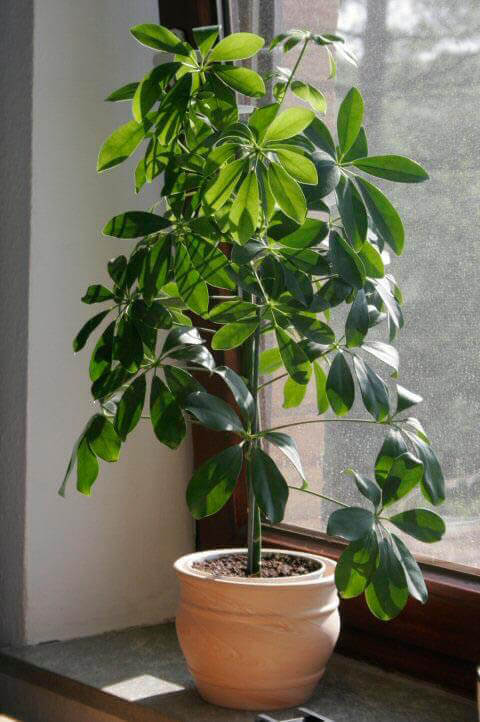
A tall and slender Umbrella Plant basking in the morning sun
However, Schefflera does have strong links to Heptapleurum, so much so the two plants are incredibly difficult to tell apart. The care instructions can be applied to both houseplants and there isn't a great deal of difference so the names tend to be used interchangeably.
You can grow it tall and reaching for the ceiling or keep it compact and short on the coffee table
An Umbrella Plant in your home or place of work should be very easy for you to take care of, in addition, it will help you out by cleaning the air for you.
They're normally undemanding and providing, as the bare minimum, you water at least a few times each month you can have a beautiful looking plant to brighten up and give structure to a dull corner or used more boldly by having it flank a doorway.
The versatility continues because you can choose to have it as a tall and slender specimen placed at floor level and reaching for the ceiling or keep it compact and short on the coffee table. It can suit many positions and will adapt to a variety of conditions.
The main downside is with age or prolonged incorrect care, the lower leaves will fall and you will have a bare lower stem but still with a full canopy. Which despite sometimes being called an Umbrella Tree, can look very odd indoors!
The plant also offers very low resistance to pests, with Red Spider Mite and Scale Insects being a common issue. All problems can be overcome, so if you'd like an Umbrella Plant as a house guest get out there and get one.
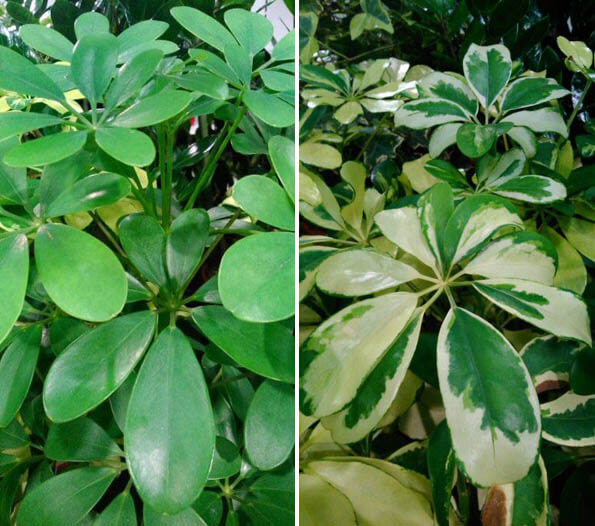
The all green vs the variegated variety, which one do you prefer?
There are several different varieties and growth habits to pick from. Firstly you need to decide if you want an all green variety or an Umbrella Plant with variegated leaves. The photo above shows you two of the most common types.
The green ones, although perhaps less attractive are much better suited to coping with less light and lower temperatures, whereas the variegation varieties are less tolerant of such conditions and have a shorter height. You do need to think about the ultimate placement in your home first, but other than that pick your favorite.
Which ones to look out for?
There are several varieties which are particular highlights and worth looking for, which includes "Gold Capella", "Green Gold" and "Compacta".
S. actinophylla tends to have more all green varieties and even when there is variegation it's slight and subtle. Whereas S. arboricola is the name you want to be searching for if you want variegation. This species tends to be more common these days so you will probably come across the variegated types much more frequently in shops.
The care is almost always the same no matter what variety you've gone for or if you picked all green or variegated. With that in mind, all the care instructions you need to know are just below.

Hi, I'm Tom!
If you're like me and enjoy the challenge of growing houseplants and getting them to thrive, then Ourhouseplants can help. This website shares my knowledge and years of growing plants and provides (hopefully) helpful advice on properly caring for your indoor plant friends.
Choose a position that offers good light without direct sunlight if you want the best results, in time this will result in a neat bushy plant that will grow reasonably straight up and become tall and "tree" like.
However Schefflera is an accommodating plant for the most part so even if you choose a slightly darker home for it, things should still work out. Although it will grow slower and potentially have more of a leggy appearance as the leaves will be spaced out more. You will also have to rotate the pot a little every week or so to keep it straight, otherwise it will lean and bend towards the light source.
Some early morning or late evening direct sunlight will be tolerated, but more than a few hours a day will cause scorch damage to the leaves.
The Umbrella Plant loves to be growing in moist soil for really good growth to occur, but it will certainly accept some underwatering. So if you forget to water it for a week or two after the soil last dried out, it should forgive you.
It's not so forgiving of being overwatered though which can result in root and stem rot. Pour any excess water collected in the drip tray away to avoid this problem. In general the bigger the plant the more water it's going to need except when it becomes inactive in Winter, at which point just water enough to keep it ticking over.
So, taking the above into account, a good rule of thumb is to try and water your plant when the top inch of soil dries out. In most homes this will likely be once a week, but this could be longer if the location is cool or there isn't a great deal of light. On the flip side, bright spots with warm temperatures could have you reaching for the watering can more frequently.
Umbrella Plants are very popular with Insects - High humidity levels can help you keep them at bay
Many modern houseplants aren't usually too fussed about humidity, or rather the typically humidity levels you would expect in a home or office.
However these plants are very popular with insects like Red Spider Mite and Scale, so if you keep having problems with these bugs you might want to look at findings ways to make the atmosphere more humid to deter them permanently.
Umbrella Plants can put out a lot of leaf and stem growth over a growing season so they do need regular feeding to fuel and sustain that level of growth. Use a general fertiliser at normal strength every couple of weeks, follow the manufacturer's instructions.
Stop feeding when the temperature drops or whenever the plant becomes inactive. You may also want to seriously reduce or stop altogether when you decide it's tall enough and has reached its ultimate (or desired) height.
Scheffleras like an all year round temperature range between 15°C (59°F) to 21°C (70°F). The all green variety tends to be happier at the lower end of the scale whereas the variegated types prefer the upper temperature levels. If things get too cold, leaves will fall off.
The Umbrella Plant can do quite well in a small pot in comparison to its potentially very tall size. Which pretty helpful and kind to your back when it comes to dragging them outside to the potting shed as they do need to be repotted every two or three years even when they've reached maturity.
Young plants should be potted up into a new container that's a little bit bigger than the last one and you can do the same with mature plants. However you could simply top dress, by scraping off the top inch of soil and replacing it with fresh compost.
In both cases use it's perfectly fine to use a standard houseplant compost or general potting soil. There is no need to feed your plant after repotting for at least 2 or 3 months because the fresh compost will typically contain enough nutrients to be going on with.
It's not easy to propagate these houseplants for the average grower (we've never really had much luck), but if you fancy giving it a go you need to remove the growing tips in Spring and use them as propagation material (cuttings).
Take a cutting of around 5cm / 2 inches or so and place it into similar soil that the parent should be growing in i.e. potting soil or a shop brought compost. It's probably a good idea to use a rooting hormone if you have one and, although it probably sounds like common sense be sure the growing tip is facing upwards and not into the soil!
This is one of the fastest growing houseplants. In the growing months of Spring and Summer, good light levels, regular watering and feeding along with warmth will give your plant a cheetah speed of houseplant growth. So much so you could potentially grow an average sized Umbrella Plant to a very tall one in the space of just one growing season.
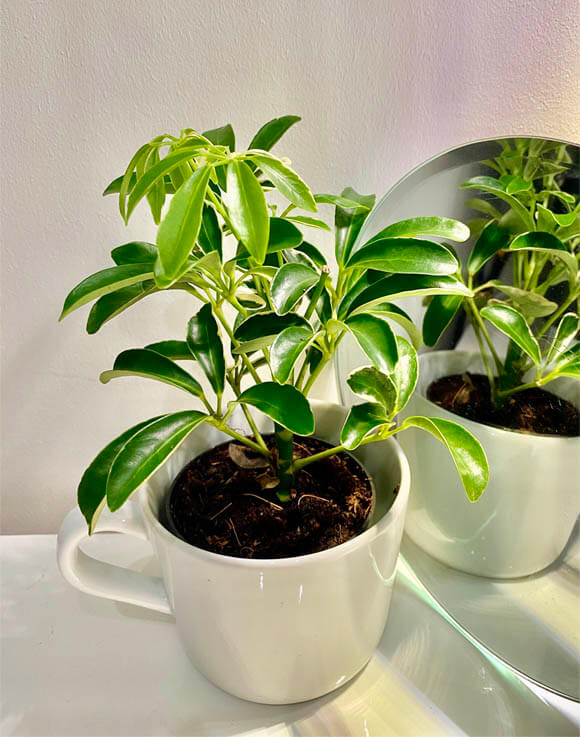
Small at the moment, but in a few years it will be a giant
When the temperature drops and the light levels decrease as Winter approaches the growth grinds to a standstill and you won't get anything else until the following Spring. This will also happen if you decide to put your plant in a location in your home that receives low light.
The Umbrella Plant can either become a tall beast in your home or you can tame it to keep it short and compact. If you opt for the latter you simply need to pinch off the upward growing shoots which will create more growth lower down the central stem, so the overall height is in your control.
If you opt for the tall appearance you leave the growing shoots well alone (unless you are trying to maintain a shape) and let it climb. It could easily reach 1.8m / 6ft indoors. Whichever look you go for, the plant will be quite slender with it only spreading to 75cm / 18in at most.
You almost exclusively only buy a Schefflera for its foliage so don't expect showy flowers on your indoor Umbrella Plant. If you get one with unusual leaf markings you could very well be adding one of the most gorgeous looking contrasting houseplants to your collection.
There is a lot of individuality between these plants, even of the same variety, so do take your time when picking and choose something you personally find attractive.
Umbrella Plants do flower on occasion. In our comments below several readers have shared photos and stories. It seems to be that only mature (over 30 years old) and well cared for plants flower indoors. We're posted a photo of one below so you can see what they look like.
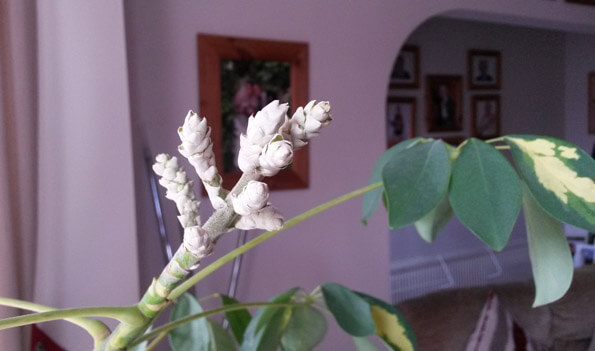
Although it's not common to see indoors, these plants do flower. Eventually.
The leaves and stems have sap that contains calcium oxalate crystals which can cause irritation of the lips, mouth and tongue.
So while unlikely to create serious consequences if eaten, this is still a plant you need to keep away from pets or children if they've been known to eat houseplants in the past.
Due to the speed of growth, a young Umbrella Plant can change drastically in the course of only one season. Young plants will have four or five leaflets per stem which increases to 12 or more on maturity. There is nothing you can do about the changes, i.e. you can't make it grower fewer leaflets or more.
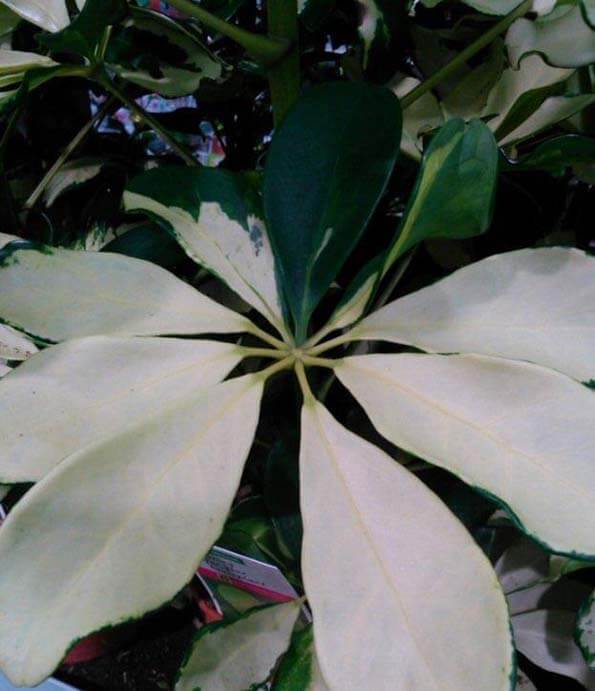
However you can keep the plant short by pinching out the growing tips, this will keep the youthful look of fewer leaflets for a longer time if you prefer that look. The leaflets look best in their natural form - slightly glossy, so be sure to wash that dust off when it builds up.
Good Light Levels This houseplant will do best in a bright but indirect light position. Avoid deep shade or prolonged direct sunlight.
Average Watering Water well then wait until the top inch of soil dries out. Potentially you could be watering once a week if all other conditions are perfect.
Average Temperature Provide temperatures between 15°C (59°F) and 21°C (70°F) all year round.
Feeding Provide a weak feed to the soil once or twice a month.
Sticky leaves with clear or black residue
Of all the houseplants we've ever owned, the Umbrella Plant seems to fall victim to Scale Insects more than any other. The insects are great at hiding and going unnoticed unless you're really spending time looking for them.
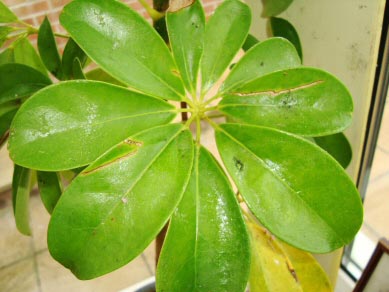
The familiar and dreaded sticky mess caused by Scale
Meanwhile they secrete a clear sticky substance that if left will spread to nearby furnishings before attracting mold and eventually turning everything black and sooty. Once the infestation has set in, it's very hard to rid your plant of this pest, but it can be done. Check out our Pest page on Scale Insects for more information.
Crooked or bent stem
Once the main stems stop growing straight up and have a crooked or bent look, they stay like that. The central stem basically grows in the direction of the main light source. So if the location is generally bright or the light is directly above it, for example if you have a skylight overhead, then you will get a plant growing straight up.
If the light source is perhaps just coming from one window and the light falls onto the plant from the side (which most places like this will), then your plant will start to bend and lean towards the window.
The fix for this is to rotate your plant's container about 90° degrees (1/4) every couple of weeks. The plant will continue trying to grow to the window, but the twisting effect will help keep the growth balanced and the central stem straight.
Leaf Fall / Yellow leaves on Umbrella Plant
If temperatures go very low, or if there is a sharp change to the surrounding atmosphere (like moving it around roughly or putting it outside with lots of wind etc) the plant could respond by dropping its lower leaves. This is not good as the lower leaves do not grow back so if you want a "full pillar" of a plant you want to treat it with respect to avoid this problem.
Drooping leaves
Umbrella Plants have dropping leaves whenever your watering skills are a bit off. Either you've been giving too much too frequently, or not enough. Only you can know which one is the culprit - have a feel of the soil to know which it is and go from there.
Further reading -
How often should I water my plants?
No growth / pale leaves
Providing it's the growing season and not the middle of Winter no growth or pale leaves on your Umbrella Plant is normally an issue caused by the need for fertiliser. Don't overdose to compensate as this could cause more problems, just use the feed as instructed by the manufacturer.
If there are no improvements within a month or two, then read through our care instructions above and see if you are following our advice in other areas.
(Article / Gallery) Photo of the Umbrella Plant with yellow / green leaves to Yercaud-elango